The Brand New Box Rails Book
Getting started with Rails for the benefit of everyone
How To Create Nested Resources for a Ruby on Rails Application
As you add complexity to your Rails applications, you will likely work with multiple models, which represent your application’s business logic and interface with your database. Adding related models means establishing meaningful relationships between them, which then affect how information gets relayed through your application’s controllers, and how it is captured and presented back to users through views.
In this section, you will build on our existing bnb-library Rails application. This application already has a model for handling book data, but you will add a nested resource for reviews about individual books. This will allow users to build out a wider body of thoughts and opinions about individual books.
Step 1 — Scaffolding the Nested Model
Our application will take advantage of Active Record associations to build out a relationship between Book and Reviews models: reviews will belong to particular books, and each book can have multiple reviews. Our Book and Review models will therefore be related through belongs_to and has_many associations.
The first step to building out the application in this way will be to create a Reivew model and related resources. To do this, we can use the rails generate scaffold command, which will give us a model, a database migration to alter the database schema, a controller, a full set of views to manage standard Create, Read, Update, and Delete (CRUD) operations, and templates for partials, helpers, and tests. We will need to modify these resources, but using the scaffold command will save us some time and energy since it generates a structure we can use as a starting point.
First, make sure that you are in the bnb-library directory for the Rails project that you created in the prerequisites:
Create your Review resources with the following command:
dip rails generate scaffold Reviews body:text book:references
With body:text, we’re telling Rails to include a body field in the reviews database table — the table that maps to the Review model. We’re also including the :references keyword, which sets up an association between the Book and Review models. Specifically, this will ensure that a foreign key representing each book entry in the books database is added to the reviews database.
Once you have run the command, you will see output confirming the resources that Rails has generated for the application. Before moving on, you can check your database migration file to look at the relationship that now exists between your models and database tables.
You will see the following (the timestamp in the filename will be different):
db/migrate/20210324201444_create_reviews.rbclass CreateReviews < ActiveRecord::Migration[6.1]
def change
create_table :reviews do |t|
t.text :body
t.references :book, null: false, foreign_key: true
t.timestamps
end
end
end
As you can see, the table includes a column for a book foreign key. This key will take the form of model_name_id — in our case, book_id.
Rails has established the relationship between the models elsewhere as well. Take a look at the newly generated Review model:
app/models/review.rbclass Review < ApplicationRecord
belongs_to :book
end
The belongs_to association sets up a relationship between models in which a single instance of the declaring model belongs to a single instance of the named model. In the case of our application, this means that a single review belongs to a single book.
In addition to setting this relationship, the rails generate scaffold command also created routes and views for reviews, as it did for our book resources in Step 3 of Scaffolding.
This is a useful start, but we will need to configure some additional routing and solidify the Active Record association for the Book model in order for the relationship between our models and routes to work as desired.
Step 2 — Specifying Nested Routes and Associations for the Parent Model
Rails has already set the belongs_to association in our Review model, thanks to the :references keyword in the rails generate scaffold command, but in order for that relationship to function properly we will need to specify a has_many association in our Book model as well. We will also need to make changes to the default routing that Rails gave us in order to make reviews resources the children of book resources.
To add the has_many association to the Book model, open app/models/book.rb using VSCode, and add the following line to the file to establish the relationship between books and reviews:
app/models/book.rbclass Book < ApplicationRecord
has_many :reviews
validates :title, presence: true, uniqueness: true
validates :description, presence: true
validates :price, presence: true
end
One thing that is worth thinking about here is what happens to reviews once a particular book is deleted. We likely do not want the reviews associated with a deleted book persisting in the database. To ensure that any reviews associated with a given book are eliminated when that book is deleted, we can include the option with the association.
Add the following code to the file to ensure that the action on a given book deletes any associated reviews:
app/models/book.rbclass Book < ApplicationRecord
has_many :reviews, dependent: :destroy
validates :title, presence: true, uniqueness: true
validates :description, presence: true
validates :price, presence: true
end
Once you have finished making these changes, save and close the file.
Next, open your config/routes.rb file to modify the relationship between your resourceful routes:
Currently, the file looks like this:
config/routes.rbRails.application.routes.draw do
resources :reviews
resources :books
root "books#index"
# For details on the DSL available within this file, see https://guides.rubyonrails.org/routing.html
end
The current code establishes an independent relationship between our routes, when what we would like to express is a dependent relationship between books and their associated reviews.
Let’s update our route declaration to make :books the parent of :reviews. Update the code in the file to look like the following:
------------------
Rails.application.routes.draw do
resources :books do
resources :reviews
end
root "books#index"
# For details on the DSL available within this file, see https://guides.rubyonrails.org/routing.html
end
Save and close the file when you are finished editing.
With these changes in place, you can move on to updating your reviews controller.
Step 3 — Updating the Reviews Controller
The association between our models gives us methods that we can use to create new review instances associated with particular books. To use these methods, we will need to add them our review controller.
Open the review controller file, and currently, the file looks like this:
app/controllers/reviews_controller.rbclass ReviewsController < ApplicationController
before_action :set_review, only: %i[ show edit update destroy ]
# GET /reviews or /reviews.json
def index
@reviews = Review.all
end
# GET /reviews/1 or /reviews/1.json
def show
end
# GET /reviews/new
def new
@review = Review.new
end
# GET /reviews/1/edit
def edit
end
# POST /reviews or /reviews.json
def create
@review = Review.new(review_params)
respond_to do |format|
if @review.save
format.html { redirect_to @review, notice: "Review was successfully created." }
format.json { render :show, status: :created, location: @review }
else
format.html { render :new, status: :unprocessable_entity }
format.json { render json: @review.errors, status: :unprocessable_entity }
end
end
end
# PATCH/PUT /reviews/1 or /reviews/1.json
def update
respond_to do |format|
if @review.update(review_params)
format.html { redirect_to @review, notice: "Review was successfully updated." }
format.json { render :show, status: :ok, location: @review }
else
format.html { render :edit, status: :unprocessable_entity }
format.json { render json: @review.errors, status: :unprocessable_entity }
end
end
end
# DELETE /reviews/1 or /reviews/1.json
def destroy
@review.destroy
respond_to do |format|
format.html { redirect_to reviews_url, notice: "Review was successfully destroyed." }
format.json { head :no_content }
end
end
private
# Use callbacks to share common setup or constraints between actions.
def set_review
@review = Review.find(params[:id])
end
# Only allow a list of trusted parameters through.
def review_params
params.require(:review).permit(:body, :book_id)
end
end
Like our books controller, this controller’s methods work with instances of the associated Review class. For example, the new method creates a new instance of the Review class, the index method grabs all instances of the class, and the set_review method uses find and params to select a particular review by id. If, however, we want our review instances to be associated with particular book instances, then we will need to modify this code, since the
Review class is currently operating as an independent entity.
Our modifications will make use of two things: first, the methods that became available to us when we added the belongs_to and has_many associations to our models. Specifically, we now have access to the build method thanks to the has_many association we defined in our Book model. This method will allow us to create a collection of review objects associated with a particular book object, using the book_id foreign key that exists in our books database. And second, the routes and routing helpers that became available when we created a nested reviews route. For a full list of example routes that become available when you create nested relationships between resources, see the Rails documentation. For now, it will be enough for us to know that for each specific book — say books/1 — there will be an associated route for reviews related to that book: books/1/reviews. There will also be routing helpers like book_reviews_path(@book) and edit_book_reviews_path(@book) that refer to these nested routes.
In the file, we’ll begin by writing a method, get_book, that will run before each action in the controller. This method will create a local @book instance variable by finding a book instance by book_id. With this variable available to us in the file, it will be possible to relate reviews to a specific book in the other methods.
Above the other private methods at the bottom of the file, add the following method:
app/controllers/reviews_controller.rbprivate
def get_book
@book = Book.find(params[:book_id])
end
# Use callbacks to share common setup or constraints between actions.
Next, add the corresponding filter to the top of the file, before the existing filter:
app/controllers/reviews_controller.rbclass ReviewsController < ApplicationController
before_action :get_book
This will ensure that get_book runs before each action defined in the file.
Next, you can use this @book instance to rewrite the index method. Instead of grabbing all instances of the Review class, we want this method to return all review instances associated with a particular book instance.
Modify the index method to look like this:
app/controllers/reviews_controller.rb# GET /reviews or /reviews.json
def index
@reviews = @book.reviews
end
The new method will need a similar revision, since we want a new review instance to be associated with a particular book. To achieve this, we can make use of the build method, along with our local @book instance variable.
Change the new method to look like this:
app/controllers/reviews_controller.rb# GET /reviews/new
def new
@review = @book.reviews.build
end
This method creates a review object that’s associated with the specific book instance from the get_book method.
Next, we’ll address the method that’s most closely tied to new: create. The create method does two things: it builds a new review instance using the parameters that users have entered into the new form, and, if there are no errors, it saves that instance and uses a route helper to redirect users to where they can see the new review. In the case of errors, it renders the new template again.
Update the create method to look like this:
app/controllers/reviews_controller.rb# POST /reviews or /reviews.json
def create
@review = @book.reviews.build(review_params)
respond_to do |format|
if @review.save
format.html { redirect_to book_reviews_path(@book), notice: "Review was successfully created." }
format.json { render :show, status: :created, location: @review }
else
format.html { render :new, status: :unprocessable_entity }
format.json { render json: @review.errors, status: :unprocessable_entity }
end
end
end
Next, take a look at the update method. This method uses a @review instance variable, which is not explicitly set in the method itself. Where does this variable come from?
Take a look at the filters at the top of the file. The second, auto-generated before_action filter provides an answer:
The update method (like show, edit, and destroy) takes a @review variable from the set_review method. That method, listed under the get_book method with our other private methods, currently looks like this:
app/controllers/reviews_controller.rbprivate
# Use callbacks to share common setup or constraints between actions.
def set_review
@review = Review.find(params[:id])
end
In keeping with the methods we’ve used elsewhere in the file, we will need to modify this method so that @review refers to a particular instance in the collection of reviews that’s associated with a particular book. Keep the build method in mind here — thanks to the associations between our models, and the methods (like build) that are available to us by virtue of those associations, each of our review instances is part of a collection of objects that’s associated with a particular book. So it makes sense that when querying for a particular review, we would query the collection of reviews associated with a particular book.
Update set_review to look like this:
app/controllers/reviews_controller.rbprivate
# Use callbacks to share common setup or constraints between actions.
def set_review
@review = @book.reviews.find(params[:id])
end
Instead of finding a particular instance of the entire Review class by id, we instead search for a matching id in the collection of reviews associated with a particular book.
With that method updated, we can look at the update and destroy methods.
The update method makes use of the @review instance variable from
set_review, and uses it with the review_params that the user has entered in the edit form. In the case of success, we want Rails to send the user back to the index view of the reviews associated with a particular book. In the case of errors, Rails will render the edit template again.
In this case, the only change we will need to make is to the redirect_to statement, to handle successful updates. Update it to redirect to book_review_path(@book), which will redirect to the index view of the selected book’s reviews:
app/controllers/reviews_controller.rb# PATCH/PUT /reviews/1 or /reviews/1.json
def update
respond_to do |format|
if @review.update(review_params)
format.html { redirect_to book_review_path(@book), notice: "Review was successfully updated." }
format.json { render :show, status: :ok, location: @review }
else
format.html { render :edit, status: :unprocessable_entity }
format.json { render json: @review.errors, status: :unprocessable_entity }
end
end
end
Next, we will make a similar change to the destroy method. Update the redirect_to method to redirect requests to book_review_path(@book) in the
case of success:
app/controllers/reviews_controller.rb# DELETE /reviews/1 or /reviews/1.json
def destroy
@review.destroy
respond_to do |format|
format.html { redirect_to book_reviews_path(@book), notice: "Review was successfully destroyed." }
format.json { head :no_content }
end
end
This is the last change you will make. You now have a reviews controller that looks like this:
app/controllers/reviews_controller.rbclass ReviewsController < ApplicationController
before_action :get_book
before_action :set_review, only: %i[ show edit update destroy ]
# GET /reviews or /reviews.json
def index
@reviews = @book.reviews
end
# GET /reviews/1 or /reviews/1.json
def show
end
# GET /reviews/new
def new
@review = @book.reviews.build
end
# GET /reviews/1/edit
def edit
end
# POST /reviews or /reviews.json
def create
@review = @book.reviews.build(review_params)
respond_to do |format|
if @review.save
format.html { redirect_to book_reviews_path(@book), notice: "Review was successfully created." }
format.json { render :show, status: :created, location: @review }
else
format.html { render :new, status: :unprocessable_entity }
format.json { render json: @review.errors, status: :unprocessable_entity }
end
end
end
# PATCH/PUT /reviews/1 or /reviews/1.json
def update
respond_to do |format|
if @review.update(review_params)
format.html { redirect_to book_reviews_path(@book), notice: "Review was successfully updated." }
format.json { render :show, status: :ok, location: @review }
else
format.html { render :edit, status: :unprocessable_entity }
format.json { render json: @review.errors, status: :unprocessable_entity }
end
end
end
# DELETE /reviews/1 or /reviews/1.json
def destroy
@review.destroy
respond_to do |format|
format.html { redirect_to book_review_path(@book), notice: "Review was successfully destroyed." }
format.json { head :no_content }
end
end
private
def get_book
@book = Book.find(params[:book_id])
end
# Use callbacks to share common setup or constraints between actions.
def set_review
@review = @book.reviews.find(params[:id])
end
# Only allow a list of trusted parameters through.
def review_params
params.require(:review).permit(:body, :book_id)
end
end
The controller manages how information is passed from the view templates to the database and vice versa. Our controller now reflects the relationship between our Book and Review models, in which reviews are associated with particular books. We can move on to modifying the view templates themselves, which are where users will pass in and modify Review information about particular books.
Step 4 — Modifying Views
Our view template revisions will involve changing the templates that relate to reviews, and also modifying our books show view, since we want users to see the reviews associated with particular books.
Let’s start with the foundational template for our reviews: the form partial that is reused across multiple review templates. Open that form now.
Rather than passing only the review model to the form_with form helper, we will pass both the book and review models, with review set as a child resource.
Change the first line of the file to look like this, reflecting the relationship between our book and review resources:
app/views/reviews/_form.html.erb<%= form_with(model: [@book, review]) do |form| %>
Next, delete the section that lists the book_id of the related book, since this is not essential information in the view.
The finished form, complete with our edits to the first line and without the deleted book_id section, will look like this:
app/views/reviews/_form.html.erb<%= form_with(model: [@book, review]) do |form| %>
<% if review.errors.any? %>
<div id="error_explanation">
<h2><%= pluralize(review.errors.count, "error") %> prohibited this review from being saved:</h2>
<ul>
<% review.errors.each do |error| %>
<li><%= error.full_message %></li>
<% end %>
</ul>
</div>
<% end %>
<div class="field">
<%= form.label :body %>
<%= form.text_area :body %>
</div>
<div class="actions">
<%= form.submit %>
</div>
<% end %>
Save and close the file when you are finished editing.
Next, open the index view, which will show the reviews associated with a particular book.
Thanks to the rails generate scaffold command, Rails has generated the better part of the template, complete with a table that shows the body field of each review and its associated book.
Much like the other code we have already modified, however, this template treats reviews as independent entities, when we would like to make use of the associations between our models and the collections and helper methods that these associations give us.
In the body of the table, make the following updates:
First, update review.book_id to review.book.title, so that the table will include the title field of the associated book, rather than identifying information about the book object itself:
app/views/reviews/index.html.erb<tbody>
<% @reviews.each do |review| %>
<tr>
<td><%= review.body %></td>
<td><%= review.book.title %></td>
Next, change the Show redirect to direct users to the show view for the associated book, since they will most likely want a way to navigate back to the original book. We can make use of the @book instance variable that we set in the controller here, since Rails makes instance variables created in the controller available to all views. We’ll also change the text for the link from Show to Show book, so that users will better understand its function.
Update the this line to the following:
app/views/reviews/index.html.erb<tbody>
<% @reviews.each do |review| %>
<tr>
<td><%= review.body %></td>
<td><%= review.book.title %></td>
<td><%= link_to 'Show Book', [@book] %></td>
In the next line, we want to ensure that users are routed the right nested path when they go to edit a review. This means that rather than being directed to reviews/review_id/edit, users will be directed to book/book_id/reviews/review_id/edit. To do this, we’ll use the book_review_path routing helper and our models, which Rails will treat as URLs. We’ll also update the link text to make its function clearer.
Update the Edit line to look like the following:
app/views/reviews/index.html.erb<tbody>
<% @reviews.each do |review| %>
<tr>
<td><%= review.body %></td>
<td><%= review.book.title %></td>
<td><%= link_to 'Show Book', [@book] %></td>
<td><%= link_to 'Edit Review', edit_book_review_path(@book, review) %></td>
Next, let’s add a similar change to the Destroy link, updating its function in the string, and adding our book and review resources:
app/views/reviews/index.html.erb<tbody>
<% @reviews.each do |review| %>
<tr>
<td><%= review.body %></td>
<td><%= review.book.title %></td>
<td><%= link_to 'Show Book', [@book] %></td>
<td><%= link_to 'Edit Review', edit_book_review_path(@book, review) %></td>
<td><%= link_to 'Destroy Review', [@book, review], method: :delete, data: { confirm: 'Are you sure?' } %></td>
Finally, at the bottom of the form, we will want to update the path to take users to the appropriate nested path when they want to create a new review. Update the last line of the file to make use of the new_book_review_path(@book) routing helper:
app/views/reviews/index.html.erb<%= link_to 'New Review', new_book_review_path(@book) %>
The finished file will look like this:
app/views/reviews/index.html.erb<p id="notice"><%= notice %></p>
<h1>Reviews</h1>
<table>
<thead>
<tr>
<th>Body</th>
<th>Book</th>
<th colspan="3"></th>
</tr>
</thead>
<tbody>
<% @reviews.each do |review| %>
<tr>
<td><%= review.body %></td>
<td><%= review.book.title %></td>
<td><%= link_to 'Show Book', [@book] %></td>
<td><%= link_to 'Edit Review', edit_book_review_path(@book, review) %></td>
<td><%= link_to 'Destroy Review', [@book, review], method: :delete, data: { confirm: 'Are you sure?' } %></td>
</tr>
<% end %>
</tbody>
</table>
<br>
<%= link_to 'New Review', new_book_review_path(@book) %>
Save and close the file when you are finished editing.
The other edits we will make to review views won’t be as numerous, since our other views use the form partial we have already edited. However, we will want to update the link_to references in the other review templates to reflect the changes we have made to our partial.
Open app/views/reviews/new.html.erb:
Update the link_to reference at the bottom of the file to make use of the book_reviews_path(@book) helper:
app/views/reviews/new.html.erb<%= link_to 'Back', book_reviews_path(@book) %>
Save and close the file when you are finished making this change.
Next, open the edit template:
In addition to the Back path, we’ll update Show to reflect our nested resources. Change the last two lines of the file to look like this:
app/views/reviews/edit.html.erb<%= link_to 'Show', [@book, @review] %> |
<%= link_to 'Back', book_reviews_path(@book) %>
Save and close the file.
Next, open the show template:
Make the following edits to the Edit and Back paths at the bottom of the file:
app/views/reviews/show.html.erb<%= link_to 'Edit', edit_book_review_path(@book, @review) %> |
<%= link_to 'Back', book_reviews_path(@book) %>
Save and close the file when you are finished.
As a final step, we will want to update the show view for our books so that reviews are visible for individual books. Open that file now:
Our edits here will include adding a Reviews section to the form and an Add Review link at the bottom of the file.
Below the Price for a given book, we will add a new section that iterates through each instance in the collection of reviews associated with this book, outputting the body of each review.
Add the following code below the Price section of the form, and above the redirects at the bottom of the file:
app/views/books/show.html.erb<p>
<strong>Price:</strong>
<%= @book.price %>
</p>
<h2>Reviews</h2>
<ul>
<% @book.reviews.each do |review| %>
<li><%= review.body %></li>
<% end %>
</ul>
Next, add a new redirect to allow users to add a new review for this particular book:
app/views/books/show.html.erb<%= link_to 'Edit', edit_book_path(@book) %> |
<%= link_to 'Add Review', book_reviews_path(@book) %> |
<%= link_to 'Back', books_path %>
Save and close the file when you are finished editing.
You have now made changes to your application’s models, controllers, and views to ensure that reviews are always associated with a particular book. As a final step, we can add some validations to our Review model to guarantee consistency in the data that’s saved to the database.
Step 5 — Adding Validations and Testing the Application
In Step 5 of Basic Functionality, you added validations to your Book model to ensure uniformity and consistency in the data that gets saved to the books database. We’ll now take a similar step to ensure guarantees for the reviews database as well.
Open the file where your Review model is defined:
Here, we want to ensure that reviews are not blank and that they don’t duplicate content other users may have posted. To achieve this, add the following line to the file:
app/models/review.rbclass Review < ApplicationRecord
belongs_to :book
validates :body, presence: true, uniqueness: true
end
Save and close the file when you are finished editing.
With this last change in place, you are ready to run your migrations and test the application.
First, run your migrations:
dip rails db:migrate
Next, start your server.
dip up
Navigate to your application’s root at http://localhost:3000.
The prerequisite Rails project tutorial walked you through adding and editing A Walk in the Park book entry. If you have not added any further book, the application landing page will look like this:
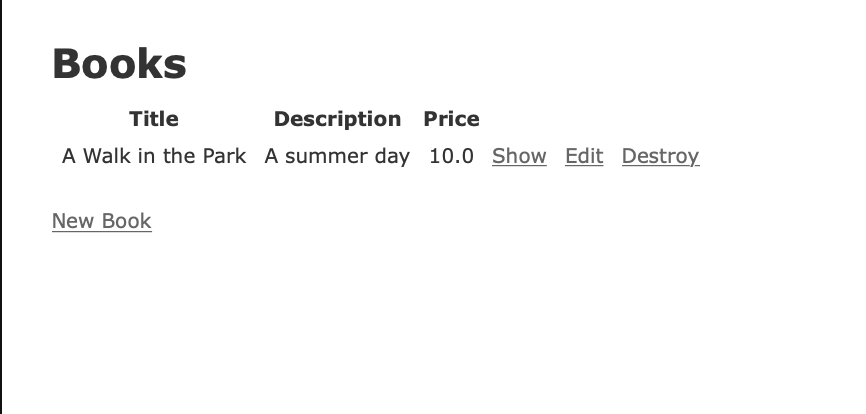 Click on Show next to the A Walk in the Park name. This will take you to the
Click on Show next to the A Walk in the Park name. This will take you to the show view for this book. You will see the title of the book, it’s description, and price, and a Reviews header with no content. Let’s add a review to populate this part of the form.
Click on Add Review below the Review header. This will bring you to the review index view, where you will have the chance to select New Review:
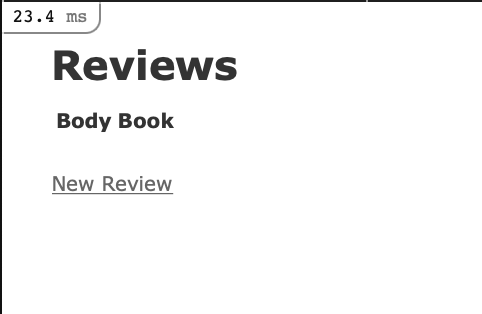 Thanks to the authentication mechanisms you put in place in Step 6 of Basic Functionality, you may be asked to authenticate with the username and password you created in that Step, depending on whether or not you have created a new session.
Thanks to the authentication mechanisms you put in place in Step 6 of Basic Functionality, you may be asked to authenticate with the username and password you created in that Step, depending on whether or not you have created a new session.
Click on New Review, which will bring you to your review new template:
 In the Body field, type, “This book is lovely!”
In the Body field, type, “This book is lovely!”
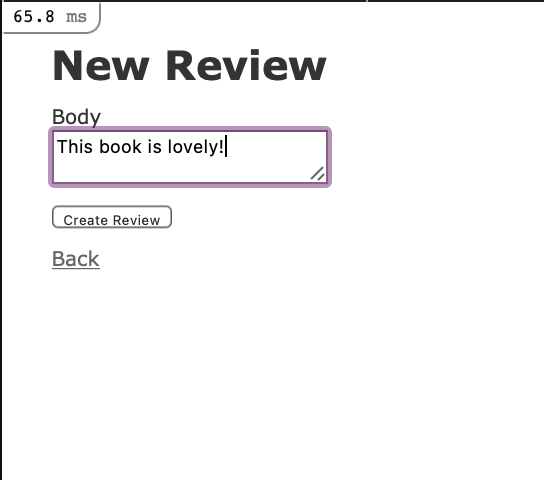 Click on Create Review. You will be redirected to the
Click on Create Review. You will be redirected to the index view for all review that belong to this book:
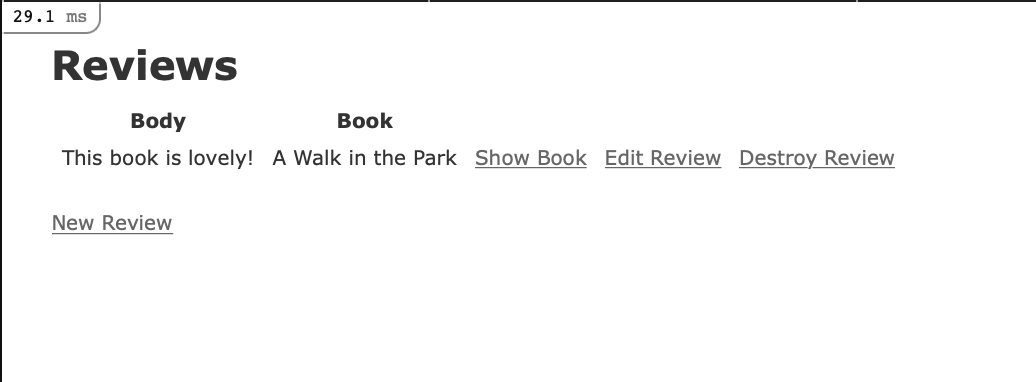 With our review resources working, we can now test our data validations to ensure that only desired data gets saved to the database.
With our review resources working, we can now test our data validations to ensure that only desired data gets saved to the database.
From the index view, click on New Review. In the Body field of the new form, try entering “This book is lovely!” again:
 Click on Create Review. You will see the following error:
Click on Create Review. You will see the following error:
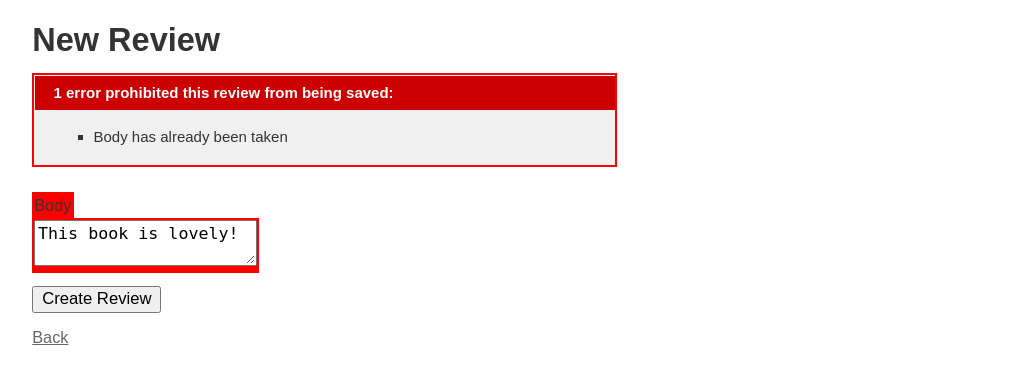 Click on Back to return to the main review page.
Click on Back to return to the main review page.
To test our other validation, click on New Review again. Leave the review blank and click Create Review. You will see the following error:
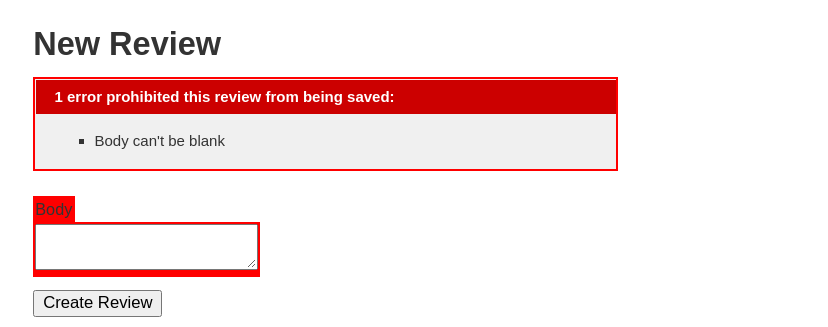 With your nested resources and validations working properly, you now have a working Rails application that you can use as a starting point for further development.
With your nested resources and validations working properly, you now have a working Rails application that you can use as a starting point for further development.
With your Rails application in place, you can now work on things like styling and developing other front-end components!